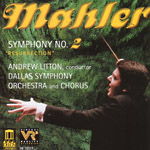Mahler’s “Resurrection” always has been the ultimate audiophile symphony, something recording producers have recognized since the dawn of hi-fi stereo, starting with Bruno Walter’s 1958 Columbia recording (which sounds stunningly clear and vibrant in Sony’s latest CD remastering). This new Delos SACD (stereo only) continues that tradition and in fact shares some of the older recording’s sonic attributes: a warm, spacious, and ideally reverberant acoustic setting (Carnegie Hall vs. Myerson Hall in Dallas), as well as minimalist miking techniques that present the performers with believable realism.
Of course, Litton’s recording has the advantage of modern DSD technology, incorporating a wide dynamic range that easily encompasses Mahler’s sonic extremes. The difference between the CD and SACD versions is most discernible in the details, as in the subtle after-reverb of cymbals, timpani, and chorus throughout the hall, or the solid placement of solo instruments and voices in three-dimensional space (particularly in the finale’s second half). More readily noticeable is the added clarity and presence–with the lights off you almost feel that you are in the recording locale–and the sense of dynamic freedom, as much as your system will allow, which makes the final peroration a spectacular listening experience (although, paradoxically, you can hear the organ better in Walter’s 45-year-old recording).
Litton’s performance also is worthy of comparison with the classics, including Walter’s, Klemperer’s, and Bernstein’s. It’s in Bernstein’s recordings that you can find points of similarity with Litton’s approach, such as his prolongation of that great build-up and collapse at the climax of the first-movement development, or the drawn-out percussion crescendos in the finale. Also like Bernstein, Litton pours on the schmaltz in the second movement and employs dramatically effective rubato throughout the symphony. Still, there’s also the sense of forward momentum of the kind found with Klemperer. The Dallas Symphony plays with remarkable brilliance, vitality, and enthusiasm–all matched by the Dallas Symphony Chorus. To top it off, Heidi Grant Murphy and Petra Lang provide heartfelt and touching solo singing. In sum, a great performance, in even greater sound.
































